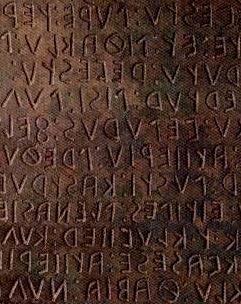

The Iguvine Tablets, also known as the Eugubian Tablets or Eugubine Tables, are a series of seven bronze tablets from ancient Iguvium (modern Gubbio), Italy, written in the ancient Italic language Umbrian. The earliest tablets, written in the native Umbrian alphabet, were probably produced in the 3rd century BC, and the latest, written in the Latin alphabet, from the 1st century BC. The tablets contain religious inscriptions that memorialize the acts and rites of the Atiedian Brethren, a group of 12 priests of Jupiter with important municipal functions at Iguvium. The religious structure present in the tablets resembles that of the early stage of Roman religion, reflecting the Roman archaic triad and the group of gods more strictly related to Jupiter. Discovered in a farmer's field near Scheggia in the year 1444, they are currently housed in the Civic Museum of the Palazzo dei Consoli in Gubbio.
Contents
- Discovery
- Decipherment
- Epigraphic note
- Date
- Content
- Tablet I
- Tablet II
- Tablets III and IV
- Tablet V
- Tablet VI and VII
- The religion of the Umbrians as reflected in the Iguvine Tablets
- The triad of the Grabovii
- The minor triad
- Other deities
- General remarks on Iguvinian theonyms
- Priesthoods
- Rites
- Treatment of the offerings
- Augury
- Augural terminology
- Topography
- Text samples
- From Tablets III and IV
- From Tablet VI
- References
- Sources
- Further reading
- External links
The tablets are the longest document of any of the Osco-Umbrian group of languages, which are closely related to Latin. The tablets shed light on the grammar of the language, and also on the religious practices of the ancient peoples of Italy, including the archaic religion of the Romans. Parts of tablets VI and VII appear to be written in an accentual metre, similar to the Saturnian metre that is encountered in the earliest Latin poetry.
The complete text, together with a translation into Latin, was published in 1849 by Aufrecht and Kirkhoff, in London in 1863 by Francis Newman, and in 1931 by Albrecht von Blumenthal. G. Devoto's edition dates from 1948. James W. Poultney published The Bronze Tables of Iguvium in 1959 (which received the Goodwin Award in 1961), which included English translations along with notes, a glossary, etc. Although the general meaning of the tablets is clear, there are still some debated points and issues. The main difficulty in understanding the text is insufficient knowledge of Umbrian vocabulary.
These are the only documents with details of sacred rituals from the ancient religions of Europe which have survived in an almost complete state.[ citation needed ] Moreover, their content deals with the rituals (sacrifices and prayers) addressed to the highest gods of the local community and to some extent may reflect the common religious beliefs and practices of the Italic peoples.
The modern Festival of Ceri, celebrated every year in Gubbio on May 15 in honor of Bishop Ubald or Ubaldo of Gubbio (1084–1160), shares certain features with the rites described in the text and so may be a survival of that ancient pre-Christian custom. It is also celebrated in Jessup, Pennsylvania, a town with a large number of immigrants from the Gubbio area, as Saint Ubaldo Day. [1]